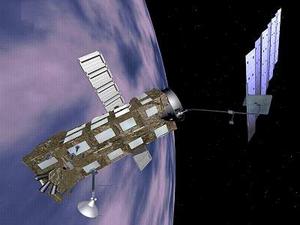Planetary securityOut-of-control giant satellite poses “Gravity”-style space debris threat
Envisat, a £1.8 billion, 9-meter-long behemoth, was launched by the European Space Agency (ESA) in 2002, and used ten sophisticated sensors to observe and monitor Earth’s land, atmosphere, oceans and ice caps. ESA, however, lost contact with the satellite in April 2012 — and declared the end of the mission soon after. The satellite now orbits the Earth free from human control at an altitude of 790 km — where the amount of space debris around the planet is greatest. In a paper, University of Leicester students point out that unless it is brought under control, Envisat could potentially pose a threat similar to the events which plague Sandra Bullock in the Oscar-nominated sci-fi thriller “Gravity.”

Giant Envisat satellite about to become incoming space debris // Source: nasa.gov
Physics students at the University of Leicester have pointed out that the huge observational satellite Envisat — which lost contact with Earth in 2012 — could potentially pose a threat similar to the events which plague Sandra Bullock in the Oscar-nominated sci-fi thriller “Gravity.”
What is more, the task of bringing the satellite back to Earth may be too costly and complex to be feasible, according to their final year paper for the Journal of Physics Special Topics, a peer-reviewed student journal run by the University’s Department of Physics and Astronomy.
A University of Leicester release reports that Envisat, a £1.8 billion, 9-meter-long behemoth, was launched by the European Space Agency (ESA) in 2002, and used ten sophisticated sensors to observe and monitor Earth’s land, atmosphere, oceans and ice caps.
ESA, however, lost contact with the satellite in April 2012 — and declared the end of the mission soon after. The satellite now orbits the Earth free from human control at an altitude of 790 km — where the amount of space debris around the planet is greatest.
This means there is a chance of collision with other satellites and debris during the 150 years it is expected to remain in space. Each year, two objects are expected to pass Envisat to within about 200 meter and other spacecraft have had to move out of Envisat’s path.
It is possible — though unlikely — that a collision with Envisat could lead to a chain reaction effect, known as the Kessler Syndrome, where a cloud of fast-moving debris causes other collisions with orbiting bodies around the Earth.
This would not be good news for the many essential satellites and spacecraft in orbit. It could also make it difficult for future space missions to pass through the region of Envisat’s altitude, if the region becomes congested with space debris.
The fourth-year MPhys students’ paper, “De-orbiting Envisat,” suggests that around 140 kg of fuel would be required to move the satellite to a point where it would naturally return to Earth within twenty-five years.
Based on the object’s cross-sectional area and its mass, the students calculated that the satellite would need to be moved to an altitude of 700 km from its current position in order to return to the planet in twenty-five years.
